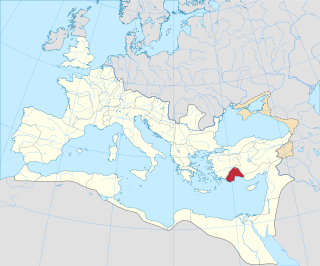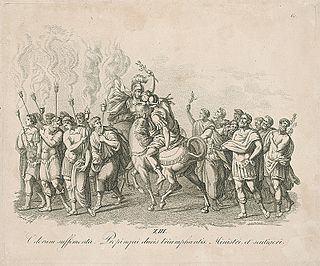Related Research Articles

Lycia and Pamphylia was the name of a province of the Roman empire, located in southern Anatolia. It was created by the emperor Vespasian, who merged Lycia and Pamphylia into a single administrative unit. In 43 AD, the emperor Claudius had annexed Lycia. Pamphylia had been a part of the province of Galatia.
Lucius Minicius Natalis was a Roman senator and military leader who occupied a number of offices in the imperial service. He was suffect consul in 106 with Quintus Licinius Silvanus Granianus Quadronius Proculus as his colleague. He is known entirely from inscriptions.
Gaius Antius Aulus Julius Quadratus was a Roman senator from Pergamon, who was appointed consul twice, in AD 94 and then in AD 105, the first senator from the Eastern Mediterranean to achieve the ordinary consulship.
Lucius Catilius Severus Julianus Claudius Reginus was a Roman senator and general active during the reigns of Trajan and Hadrian. He was appointed consul twice: the first time in 110 CE with Gaius Erucianus Silo as his colleague; the second in the year 120 with the future emperor Antoninus Pius as his colleague. Catilius was also the step-great-grandfather of the emperor Marcus Aurelius.
Lucius Julius Marinus Caecilius Simplex was a Roman senator who held several posts in the emperor's service. Simplex was then appointed suffect consul in late 101, with Lucius Arruntius Stella as his colleague. His career is primarily known through inscriptions.
Marcus Paccius Silvanus Quintus Coredius Gallus Gargilius Antiquus was a Roman senator of the 2nd century. He was suffect consul in the nundinium of May to June 119 as the colleague of Quintus Vibius Gallus. Gargilius Antiquus is primarily known through inscriptions.
Lucius Domitius Apollinaris was a Roman senator of the late first century. He is best known for his literary activities, as an acquaintance of Pliny the Younger and a patron of the poet Martial. He was appointed suffect consul in the nundinium of July to August 97 with Sextus Hermentidius Campanus as his colleague.

Quintus Pomponius Rufus was a Roman senator active in the imperial service; he was governor during the reigns of the emperors Domitian and Trajan. Rufus was also suffect consul for the nundinium September-December AD 95 as the colleague of Lucius Baebius Tullus. Pomponius Rufus is known primarily from inscriptions.
Publius Nonius Asprenas Caesius Cassianus was a Roman senator who was active in the first century. He was appointed suffect consul by Vespasian in either 72 or 73. Cassianus is known only through inscriptions. He is identified as the son of Publius Nonius Asprenas Calpurnius Serranus, ordinary consul of 38.

Lucius Valerius Propinquus was a Roman senator active in the second century AD. He was suffect consul who replaced the ordinary consul Marcus Annius Verus and was the colleague of the other ordinary consul, Gaius Eggius Ambibulus, for the remainder of the first nundinium of 126.
Senecio Memmius Afer was a Roman senator active in the last quarter of the first century AD. He was suffect consul for the nundinium of June to July AD 99 as the colleague of Publius Sulpicius Lucretius Barba. Afer is known primarily from inscriptions.
Gaius Calpurnius Flaccus was a Roman senator of the second century. He was attested suffect consul with Lucius Trebius Germanus as his colleague on 15 December of an undetermined year between 122 and 127. Both Flaccus and Germanus are primarily known from inscriptions.
Gaius Ummidius Quadratus Sertorius Severus was a Roman senator active during the second century AD. He was suffect consul in absentia for the nundinium of May to June 118 as the colleague of the emperor Hadrian. He is more frequently known by his shorter name, Gaius Ummidius Quadratus; his full name was known only after a missing piece to an inscription from Tomis was found.
Titus Calestrius Tiro Orbius Speratus was a Roman senator who held a series of offices in the emperor's service. He was suffect consul late in the year 122 as the colleague of Gaius Trebius Maximus.
Gaius Quinctius Certus Poblicius Marcellus was a Roman senator active in the first quarter of the second century AD. He was suffect consul for the nundinium of May to June AD 120, with Titus Rutilius Propinquus as his colleague. The more common and shorter version of his name is Gaius Poblicius Marcellus; he is known primarily from inscriptions. He later served in Syria as the imperial legate.
Titus Pomponius Antistianus Funisulanus Vettonianus was a Roman senator active in the first quarter of the second century AD. He was suffect consul for the nundinium of May to June AD 121 with Lucius Pomponius Silvanus as his colleague. Vettonianus is known only from inscriptions.
Publius Valerius Patruinus was a Roman senator, who flourished under the reign of Domitian. He was suffect consul in the nundinium of July–August 82 with Lucius Antonius Saturninus as his colleague. He is known entirely from inscriptions.
Quintus Voconius Saxa Fidus was a Roman senator, who was active during middle of the second century. He was suffect consul in the nundinium September-October 146 with Gaius Annianus Verus as his colleague. He is known almost entirely from inscriptions; Voconius is mentioned once in Ulpian's Liber octavus de officio proconsulis.
Titus Statilius Maximus Severus Hadrianus was a Roman senator, who was active during the reign of Trajan. He was suffect consul in the year 115, replacing the consul Marcus Pedo Vergilianus killed by an earthquake in Antioch.
References
- ↑ Werner Eck and Andreas Pangerl, "Sex. Iulius Severus, cos. suff. 126, und seine Militärdiplome (PA 456)", Zeitschrift für Papyrologie und Epigraphik , 175 (2010), p. 253
- ↑ Eck, "Jahres- und Provinzialfasten der senatorischen Statthalter von 69/70 bis 138/139", Chiron , 13 (1983), pp. 148f, 362 n. 326
- ↑ Eck, "Jahres- und Provinzialfasten", pp. 154-156
- ↑ Syme, "Missing Persons (P-W VIII A)", Historia: Zeitschrift für Alte Geschichte , 5 (1956), p. 206
- ↑ Rémy, Les carrières sénatoriales dans les provinces romaines d'Anatolie au Haut-Empire (31 av. J.-C. - 284 ap. J.-C.) (Istanbul: Institut Français d'Études Anatoliennes-Georges Dumézil, 1989), p. 298f